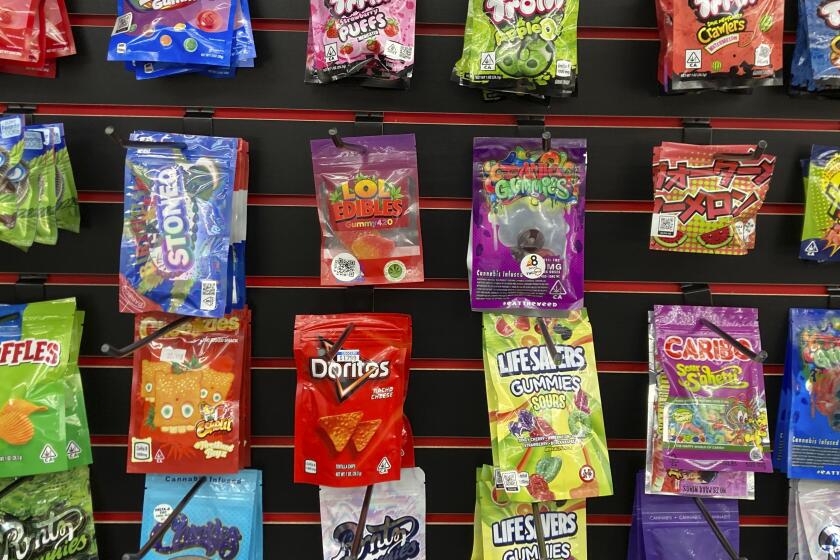More sweet potatoes grace California’s farms and Americans’ plates
Bouncing down a dirt road, past emerald fields thick with sweet potato plants, farmer Robert Garcia hunched over the steering wheel of his pickup truck and grinned with glee.
It’s the beginning of harvest season and, once again, his bounty of orange- and yellow-fleshed roots is looking promising.
“You used to see cotton fields and grapevines out here,” said Garcia, 54, whose family grows and packs sweet potatoes out of their Central California farm operations.
“Now the talk is sweet potatoes, sweet potatoes, how can I get more sweet potatoes?”
Forget the marshmallows and the Thanksgiving buffet table. The sweet potato has become a year-round food.
Over the last decade, Americans have more than doubled their consumption of the thin-skinned vegetable, according to the United States Sweet Potato Council: U.S. consumers, per capita, now wolf down 6.2 pounds of sweet potatoes each year.
Diners overseas, too, have developed a fondness for it. U.S. farmers exported 200.3 million pounds of sweet potatoes in 2010, up from 38.5 million pounds in 2000, according to U.S. Department of Agriculture’s Foreign Agricultural Service.
Here in the U.S., sweet potatoes are showing up at presidential state dinners and on White Castle’s menu. They’re cropping up in soup bowls, eating up shelf space in grocery store chip aisles, and piling up high in French fry baskets. At Umami Burger, a fast-growing Los Angeles chain, cooks can barely keep up with the demand for their sweet potato fries dusted with cinnamon and salt.
“It has a nice sweetness but is still savory,” said Adam Fleischman, chief executive of Umami Restaurant Group. “That combination, the sweet-savory, is really popular right now.”
Besides, Fleischman said, “they’re familiar to people, but still something different to try.”
Garcia, the central California farmer, sees nothing but potential for growth. Ten years ago, he and his family farmed 240 acres of sweet potatoes in Turlock and surrounding areas. Today, they’ve expanded that to 400 acres and opened a packing plant in Livingston.
Inside the facility, the air smells sweet and earthy as workers gently drop the potatoes into a washing station and hand-sort them as they move down a conveyor belt. Nearby, boxes of potatoes sit waiting for trucks to take them to Costco and other grocery retailers in the U.S.
“People love them, and farmers notice that,” Garcia said.
That growth was driven in part by a shift in nutritional and culinary circles. Although traditional white potatoes still dominate the potato market, doctors and weight-loss groups touted the benefits of whole roasted sweet potatoes — which are higher in fiber and Vitamin A than traditional white potatoes, and lower on the glycemic index.
Yet it was cooks’ slicing up sweet potatoes and dunking them into a deep fryer that fed the public demand.
The number of restaurants offering sweet potatoes has grown 14% in the last three years, according to a survey of 704 restaurant menus conducted by Chicago-based market research firm Technomic Inc. Much of that increase comes from restaurants featuring sweet potato fries.
Packaged-food giant ConAgra Foods, seeing a lucrative market, opened a new $156-million plant in Louisiana this year devoted to processing sweet potatoes into frozen fries and other products.
“If you’re in the restaurant business, you know the country is changing to healthier selections, or selections seen as being healthier,” said Harry Balzer of the NPD Group, a market research firm that has been tracking U.S. eating habits for more than three decades.
“So restaurants are looking for a new version of something the public already loves: the typical French fry.... If companies can set up the same infrastructure for processing sweet potatoes that they have for [white] potatoes for French fries, the market could be huge.”
Such potential has spurred California farmers in recent years to devote more acreage to the Southern staple. Last year they produced 639 million pounds of sweet potatoes, making California the nation’s second-largest grower, behind only North Carolina (972 million pounds) and ahead of traditional strongholds Mississippi (360 million pounds) and Louisiana (247 million pounds), according to U.S. Department of Agriculture’s National Agricultural Statistics Service.
Most of the Golden State’s sweet potato farming happens here in Merced County, an agricultural region about 100 miles southeast of Sacramento. The crop dates to the 19th century, when Portuguese and Japanese immigrants brought the plant with them, said Scott Stoddard, a farm advisor at University of California Cooperative Extension in Merced County.
Unlike other parts of the state, Stoddard said, the sandy soil here helps the transplanted slips easily spread and grow. And sweet potatoes are extremely heat tolerant, so they can handle the region’s hot summer days and moderate nights.
But farming them can be very labor intensive. Weeds are pulled by hand. Much of the harvest is done manually, too, because sweet potatoes bruise more easily than typical white potatoes. That, in turn, means profits can be thin.
“I’ve heard about people ripping out grapevines to plant sweet potatoes,” Stoddard said. “You have to remember that, at least right now, this is still a specialty niche crop.”
More to Read
Inside the business of entertainment
The Wide Shot brings you news, analysis and insights on everything from streaming wars to production — and what it all means for the future.
You may occasionally receive promotional content from the Los Angeles Times.









